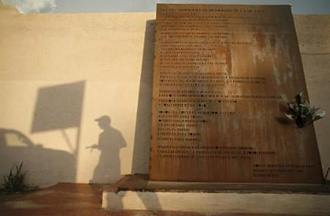 |
 |
 |
 Editorials | Opinions | August 2007 Editorials | Opinions | August 2007  
New Boots a Final Misstep in US Border Trek
 BYLINE BYLINE


| | A migrant casts his shadow on a monument outside the migrants shelters concrete facade in memory to those who died crossing the desert in the small town of Altar, some 60 miles (97 km) south of the U.S.-Mexico border in the Mexican state of Sonora July 27, 2007. (Reuters/Tomas Bravo) |
Three Points, Arizona (Reuters) - Sand coloured with a tough plastic sole, the new boots looked just the job for walking across the searing desert. They were sturdy on the feet of my walking companion.

But a few miles (km) into the trek, they began to pinch, rub and chafe, causing blisters that would be the last straw as our trip unraveled.

Mexican photographer Tomas Bravo and I set out last month to imitate more than a million dirt-poor Latin Americans who break the law each year trying to cross the 2,000-mile (3,200-km) U.S.-Mexico border on foot in search of the American Dream.

I live in Arizona and cover immigration in the United States, from border security issues to wrangling in the U.S. Congress over legislation, and I wanted to feel close up what many illegal migrants undertake.

Last year the U.S. Border Patrol detained 392,313 men, women and children crossing through the borderlands south of Tucson, Arizona - the most heavily traversed part of the international line - and counted 169 people who perished making the journey.

Most victims died of dehydration crossing the high desert corridor by day during the summer, when temperatures can soar to 109F (46 Celsius), or succumbed to the cold at night, when even July temperatures can drop back to the low 50s (10 Celsius).

The margin for error on the trip is slender. But as Tomas and I set out on the 45-mile (70-km) walk from El Sasabe, Mexico to Three Points, Arizona, I was quietly confident.

"We have planned it pretty well. Three days should be plenty of time to complete the trip," I said.

BAKING IN THE SUN

Increased security in U.S. cities on the Mexico border in recent years has driven many illegal migrants to try crossing the parched wilderness of the desert.

We had maps to help us on the trek to Three Points, a dusty hamlet where thousands of undocumented migrants pile into cars and trucks for the final leg of a journey up to Tucson and Phoenix and a new life, perhaps as a landscaper or chambermaid.

Drawing on his several years of patrolling the borderlands, Border Patrol officer Jim Hawkins ranked the perils we faced. First was running out of water in the savage heat, when border crossers need a gallon (3.8 litres) of liquid each hour.

"You can't physically carry enough water with you from the border to Three Points," he cautioned. "It's sweating right out of you, but you don't notice it because it is so arid."

Then there were the rifle-toting bandits who rob and shoot migrants dead on the back trails through the Altar Valley.

Finally, there were the rattlesnakes, scorpions and venomous black widow and brown recluse spiders, whose bite requires swift emergency room treatment.

"Everything out there either wants to sting you, bite you or scratch you," he said with a shrug.

SNOWBALLING MISSTEPS

Tomas and I packed three gallons (11 litres) of water each and decided to walk at night to beat the heat; we planned to bypass the strip of desert most frequented by bandits, and to carry a first-aid kit for bites and stings.

But - probably like many an illegal migrant - a series of trivial missteps sank us after we set off from Mexico into a gathering summer rain storm.

Soaked, tired and disoriented, I lost my sense of direction. I led us along drowned trails that took us on a full circle in a fruitless three-hour detour as we swigged our precious water.

Then there was the food. I had mislaid a packet of flour tortillas and we had only cans of tuna fish and beans that failed to boost our energy.

On top of that, I had assumed we could keep warm at night despite the nearly 30-degree plunge in temperature by walking until dawn. But Tomas' new boots put paid to that.

Halted by blisters, we shivered in the cold, finally breaking open a survival blanket and bailing out of the trek with the help of a Border Patrol agent, who picked us up from a highway at dawn on our third day.

Driving back toward Tucson, I thought of the dead. The men, women and children plucked out of the desert month after month, some little more than skeletal remains.

It may have been the heat, the cold or the bandits that took their lives, but it was a wrong turn in the dark, a twisted ankle, or even some new shoes bought for the journey that just as surely killed them. | 
 | |
 |



